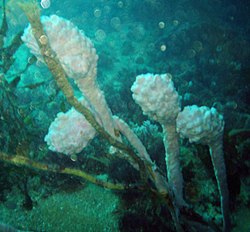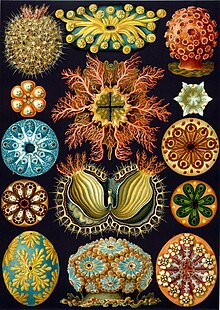Ascidiacea
| Ascidiacea | |
|---|---|

| |
| Sea Tulips, Pyura spinifera | |
| Scientific classification | |
| Kingdom: | |
| Phylum: | |
| Subphylum: | |
| Class: | Ascidiacea Nielsen, 1995
|
| Orders | |
|
Aplousobranchia | |
Ascidiacea (commonly known as the ascidians or sea squirts) is a class in the Tunicata subphylum of sac-like marine filter feeders. Ascidians are characterized by a tough outer "tunic" made of the polysaccharide tunicin whilst other tunicates are much less robust. They are found all over the world, usually in shallow water with salinities over 25%. While members of the Thaliacea and Larvacea swim freely like plankton, sea squirts are sessile animals, firmly attached to substratum such as rocks and shells. There are 2,300 species of ascidians and three main types: solitary ascidians, social ascidians that form clumped communities by attaching at their bases, and compound ascidians that consist of many small individuals forming colonies up to several meters in diameter. Sea squirts feed by taking in water through the oral siphon. The water enters the mouth and pharynx, flows through mucus-covered gill slits (also called pharyngeal stigmata) into a water chamber called the atrium, then exits through the atrial siphon.
Life History: Almost all sea squirts are hermaphrodites. Solitary sea squirts release many eggs from their atrial siphons; external fertilization in seawater takes place with the coincidental release of sperm from other individuals. A fertilized egg spends 12 hours to a few days developing into a free-swimming tadpole larva, which then takes several more hours/days to settle and metamorphose into a juvenile. The larva selects and settles on appropriate surfaces using receptors sensitive to light, orientation to gravity, and tactile stimuli. When its anterior end touches a surface, papillae (small, finger-like nervous projections) secrete an adhesive for attachment. Adhesive secretion prompts an irreversible metamorphosis: various organs (such as the larval tail and fins) are lost while others rearrange to their adult positions, the pharynx enlarges, and organs called ampullae grow from the body to permanently attach the animal to the substratum. Sexual maturity can be reached in as little as a few weeks. Most sea squirts live between 1-3 years. Colonial sea squirts reproduce both asexually and sexually. Sexually produced individuals, those that develop from fertilized eggs, first settle and mature on substratum, then bud asexually to form a colony of many small individuals. Embryonic development takes place within the established colony: eggs are fertilized and brooded in the atrium. Colonies can survive for decades.
Fertilization: Sea squirt eggs are surrounded by a fibrous vitelline coat and a layer of follicle cells that produce sperm-attracting substances. In fertilization, the sperm passes through the follicle cells and binds to glycosides on the vitelline coat. The sperm's mitochondria is left behind as the sperm enters and drives through the coat; this translocation of the mitochondria might provide the necessary force for penetration. The sperm swims through the perivitelline space, finally reaching the egg plasma membrane and entering the egg. This prompts rapid modification of the vitelline coat, through processes such as the egg's release of glycosidase into the seawater, so no more sperm can bind and polyspermy is avoided. After fertilization, free calcium ions are released in the egg cytoplasm in waves, mostly from internal stores. The temporary large increase in calcium concentration prompts the physiological and structural changes of development. The dramatic rearrangement of egg cytoplasm following fertilization, called ooplasmic segregation, determines the dorsoventral and anteroposterior axes of the embryo. There are at least three types of sea squirt egg cytoplasm: ectoplasm containing vesicles and fine particles, endoderm containing yolk platelets, and myoplasm containing pigment granules, mitochondria, and endoplasmic reticulum. In the first phase of ooplasmic segregation, the myoplasmic actin-filament network contracts to rapidly move the peripheral cytoplasm (including the myoplasm) to the vegetal pole, which marks the dorsal side of the embryo. In the second phase, the myoplasm moves to the subequatorial zone and extend into a crescent, which marks the future posterior of the embryo. The ectoplasm with the zygote nucleus ends up at the animal hemisphere while the endoplasm ends up in the vegetal hemisphere.
Ecology: The exceptional filtering capability of adult sea squirts causes them to accumulate pollutants that may be toxic to embryos and larvae as well as impede enzyme function in adult tissues. This property has made some species sensitive indicators of pollution. Over the last several hundred years, most of the world's harbors have been invaded by non-native sea squirts that have clung to ship hulls or to introduced organisms such as oysters and seaweed. Several factors, including quick attainment of sexual maturity, tolerance of a wide range of environments, and a lack of predators, allow sea squirt populations to grow rapidly. Unwanted populations on docks, ship hulls, and farmed shellfish cause significant economic problems, and sea squirt invasions have disrupted the ecosystem of several natural sub-tidal areas by smothering native animal species. Sea squirts are the natural prey of many animals, including flatworms, mollusks, rock crabs, sea stars, fish, birds, and sea otters. They are also eaten by humans in many parts of the world, including Japan, Korea, Chile, and Europe (where they are sold under the name “sea violet”). As chemical defenses, many sea squirts intake and maintain an extremely high concentration of vanadium in the blood, have a very low pH of the tunic due to acid in easily-ruptured bladder cells, and (or) produce secondary metabolites harmful to predators and invaders. Some of these metabolites are toxic to cells and are of potential use in pharmaceuticals.
Sea squirts as model organisms for research: A number of factors make sea squirts good models for studying the fundamental developmental processes of chordates, such as cell-fate specification. The embryonic development of sea squirts is simple, rapid, and easily manipulated. Because each embryo contains relatively few cells, complex processes can be studied at the cellular level, while remaining in the context of the whole embryo. The embryo's transparency is ideal for fluorescent imaging and its maternally-derived proteins are naturally pigmented, so cell lineages are easily labeled, allowing scientists to visualize embryogenesis from beginning to end. Sea squirts are also valuable because of their unique evolutionary position: as an approximation of ancestral chordates, they can provide insight into the link between non-chordate deuterostomes and chordates, as well as the origination of vertebrates. The sequenced genomes of the related sea squirts Ciona intestinalis and Ciona savignyi are small and easily manipulated; comparisons with the genomes of other organisms such as flies, nematodes, pufferfish and mammals provides valuable information regarding chordate evolution. A collection of over 480,000 cDNAs have been sequenced and are available to support further analysis of gene expression, which is expected to provide information about complex developmental processes and regulation of genes in vertebrates.

References
Further general references
- Tudge, Colin (2000). The Variety of Life. Oxford University Press. ISBN 0-19-860426-2.
External link
- Ascidiacea.com - Classification and images of many ascidians.
- Tunicate videos
- The Dutch Ascidians Homepage
- Encyclopedia of Marine Life of Britain and Ireland
- Sea squirt anatomy and feeding
- Fertilization and Development of Ascidians
- From Egg to Tadpole
- The Organization and Cell-lineage of the Ascidian Egg
- A fate map of the ascidian egg
- Ciona savignyi Database
